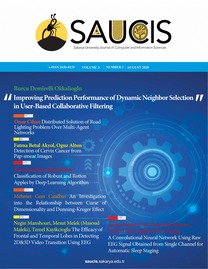Effect of the Chaotic Crossover Operator on Breeding Swarms Algorithm
___
1] Q. Liu, X. Li, H. Liu and Z. Guo, “Multi-objective metaheuristics for discrete optimization problems: A review of the state-of-the-art,” Appl Soft Comput., vol. 93, 2020.[2] J. Kennedy and R.C. Eberhart, “Particle Swarm Optimization,” IEEE Int. Conf. Neural Networks, pp. 1942-1948, 1995.
[3] W. Yanmin, “Optimization of Wireless Sensor Network for Dairy Cow Breeding Based on Particle Swarm Optimization,” Int. Conf. Intell. Trans. Big Data & Smart City (ICITBS), pp. 524-527, 2020.
[4] Y. Özger, M. Akpinar, Z. Musayev and M. Yaz, “Electrical Load Forecasting Using Genetic Algorithm Based Holt-Winters Exponential Smoothing Method,” Sakarya University Journal of Computer and Information Sciences., vol. 3, no. 2, pp.108-123, 2019.
[5] M. Settles and T. Soule, “Breeding swarms: a GA/PSO hybrid,” ACM Conf. Genetic and Evol. Comput. (GECCO ‘05), pp. 161-168, 2005.
[6] H. R. Vanamala and D. Nandur, “Genetic Algorithm and Chaotic Maps based Visually Meaningful Image Encryption,” TENCON 2019 - 2019 IEEE Region 10 Conf. (TENCON), pp. 892-896, 2019.
[7] R.C. Eberhart and Y. Shi, “Comparing inertia weights and constriction factors in particle swarm optimization,” IEEE Congr. Evol. Comput., pp. 84-88, 2000.
[8] R. Eberhart and Y. Shi, “A Modified Particle Swarm Optimizer,” IEEE World Cong. Comput. Intel., pp. 69-73, 1998.
[9] P.J. Angeline, “Using selection to improve particle swarm optimization,” IEEE World Cong. Comp. Intel., pp. 84-89, 1998.
[10] R. Brits, A.P. Engelbrecht and F. van den Bergh, “A niching particle swarm optimizer,” Proc. Sim. Evol. Learn. SEAL., 2002.
[11] F. van den Bergh and A.P. Engelbrecht, “A new locally convergent particle swarm optimizer,” IEEE Int. Conf. Syst., Man and Cyb., vol. 3, 2002.
[12] J. Kennedy, “The particle swarm: social adaptation of knowledge,” Proc. of 1997 IEEE Int. Conf. Evol. Comput., pp. 303-308, 1997.
[13] T. Krink and M. Løvebjerg, “The lifecycle model: combining particle swarm optimization, genetic algorithms and hillclimbers,” Conf. Parallel Probl. Solving Nat., 7th — PPSN VII, pp. 621-630, 1997.
[14] N. Higashi and H. Iba, “Particle swarm optimization with Gaussian mutation,” IEEE Swarm Intel. Symp. (SIS), pp. 72-79, 2003.
[15] A. Banks, J. Vincent and C. Anyakoha, “A review of particle swarm optimization. Part II: hybridisation, combinatorial, multicriteria and constrained optimization, and indicative applications,” Nat. Comput., vol. 7, pp. 109-124, 2007.
[16] J. Holland, Adaptation in Natural and Artificial Systems: An Introductory Analysis with Applications to Biology, Control, and Artificial Intelligence :2nd ed. University of Michigan Press, 1992.
[17] A. Lipowski and D. Lipowska, “Roulette-wheel selection via stochastic acceptance,” Phys. A (Amsterdam, Neth.), vol. 391, pp. 2193-2196, 2012.
[18] Y. Kaya, M. Uyar and R. Tekin, “A Novel Crossover Operator for Genetic Algorithms: Ring Crossover,” arXiv preprint arXiv:1105.0355, 2011.
[19] M.J. Varnamkhasti, L.S. Lee, M.R.A. Bakar and W.J. Leong, “A Genetic Algorithm with Fuzzy Crossover Operator and Probability,” Adv. Oper. Res., vol. 2012, Article ID 956498, 2012.
[20] D. Vrajitoru, “Crossover improvement for the genetic algorithm in information retrieval,” Inf. Process. Manage., vol. 34, pp. 405-415, 1998.
[21] M. Srinivas, “Adaptive probabilities of crossover and mutation in genetic algorithms”, IEEE Int. Conf. Syst. Man. Cyb., vol. 24, pp. 656-667, 1994.
[22] I. Abuiziah and N. Shakarneh, “A Review of Genetic Algorithm Optimization: Operations and Applications to Water Pipeline,” Int. J. of Math. Comput. Phys. Quan. Eng., vol. 7, pp.136-147, 2013.
[23] R. Sivaraj and T. Ravichandran, “A Review of Selection Methods in Genetic Algorithm,” Int. J. Eng. Sci. Technol. (IJEST), vol. 3, pp. 3792-3797, 2011.
[24] N. M. Razali and J. Geraghty, “Genetic Algorithm Performance with Different Selection Strategies in Solving TSP,” Proc. World Cong. Eng., vol. 2, 2011.
[25] O. Abdoun and J. Abouchabaka, “A Review of Selection Methods in Genetic Algorithm,” Int. J. Comp. App. (IJCA), vol. 31, pp. 49-57, 2011.
[26] R. Caponetto, L. Fortuna, S.Fazzino and M.G. Xibilia, “Chaotic sequences to improve the performance of evolutionary algorithms,” IEEE Trans. Evol. Comput., vol. 7, pp. 289-304, 2003.
[27] L. J. Yang and T. L. Chen, “Application of Chaos in Genetic Algorithms,” Commun. Theor. Phys., vol. 38, pp. 168-172, 2002.
[28] B. Alatas, E. Akin and A.B. Ozer, “Chaos embedded particle swarm optimization algorithms,” Chaos, Solitons Fractals, vol. 40, pp. 1715-1734, 2009.
- ISSN: 2636-8129
- Yayın Aralığı: Yılda 3 Sayı
- Başlangıç: 2018
Detection of Pneumonia with a Novel CNN-based Approach
Deep Neural Networks Based on Transfer Learning Approaches to Classification of Gun and Knife Images
Mehmet Tevfik AĞDAŞ, Muammer TÜRKOĞLU, Sevinç GÜLSEÇEN
Halil İbrahim CEBECİ, Yasemin KORKUT
Deep Learning Methods for Autism Spectrum Disorder Diagnosis Based on fMRI Images
Muhammed Ali BAYRAM, İlyas ÖZER, Feyzullah TEMURTAŞ
A Study on the Efficacy of Deep Reinforcement Learning for Intrusion Detection
Halim Görkem GÜLMEZ, Pelin ANGİN
A Conjoint Analysis of Propellant Budget and Maneuver Life for a Communication Satellite
Sentiment Analysis on Social Media Reviews Datasets with Deep Learning Approach
MUHAMMET SİNAN BAŞARSLAN, FATİH KAYAALP
A V-Model Software Development Application for Sustainable and Smart Campus Analytics Domain
ONUR DOĞAN, Semih BİTİM, Abdulkadir HIZIROĞLU
Performance Evaluation of MANET Routing Protocols AODV and DSDV Using NS2 Simulator
